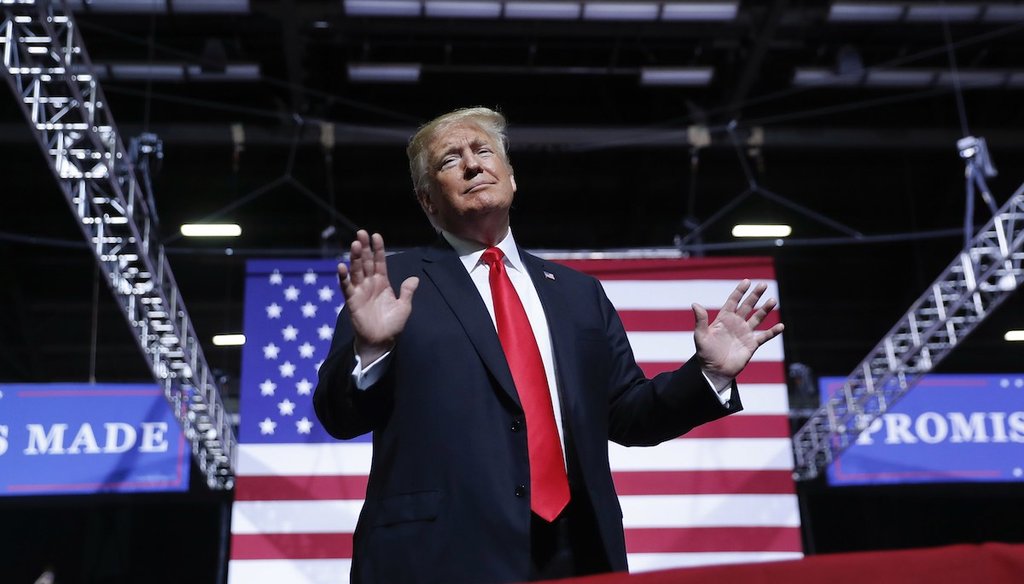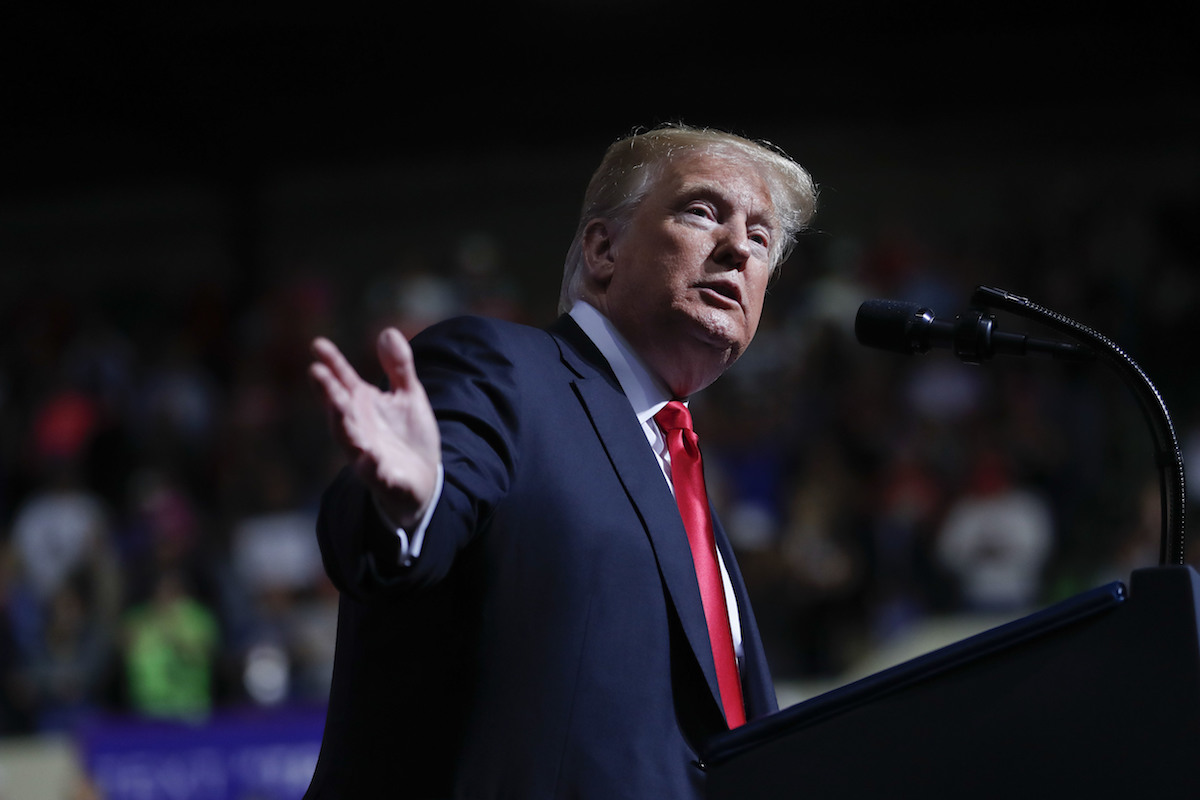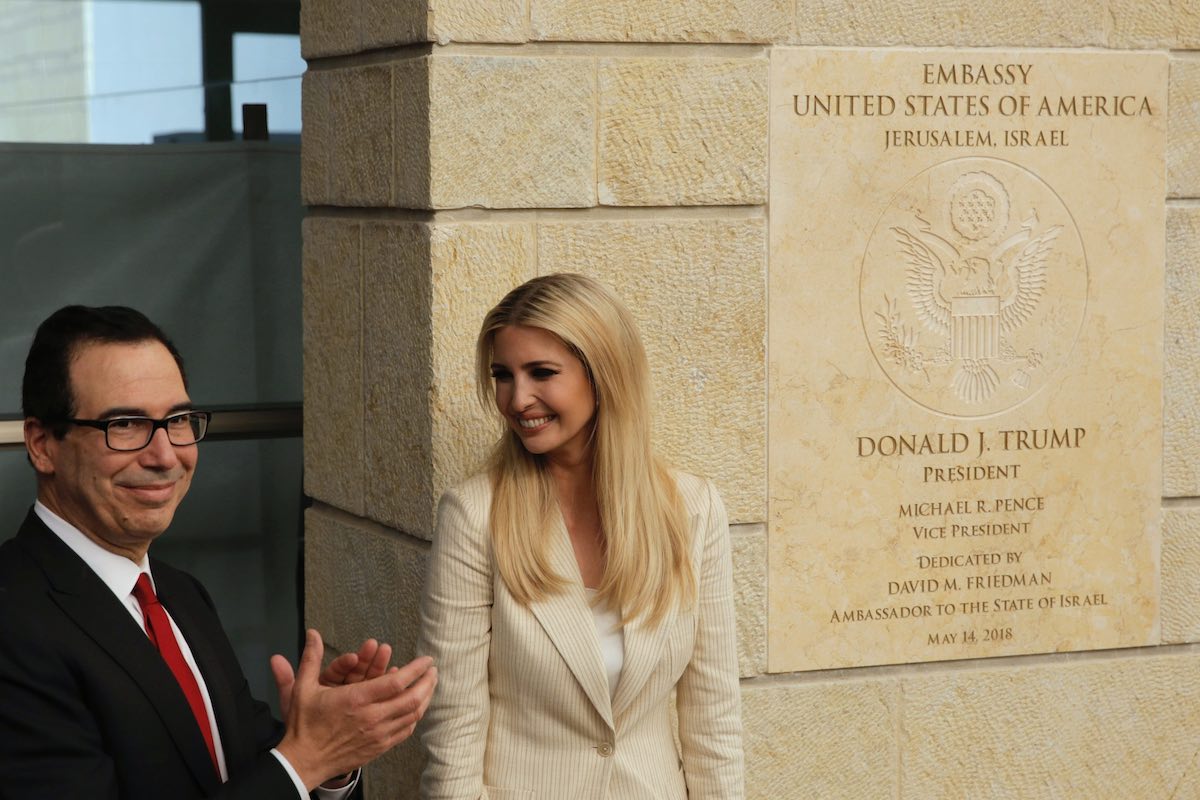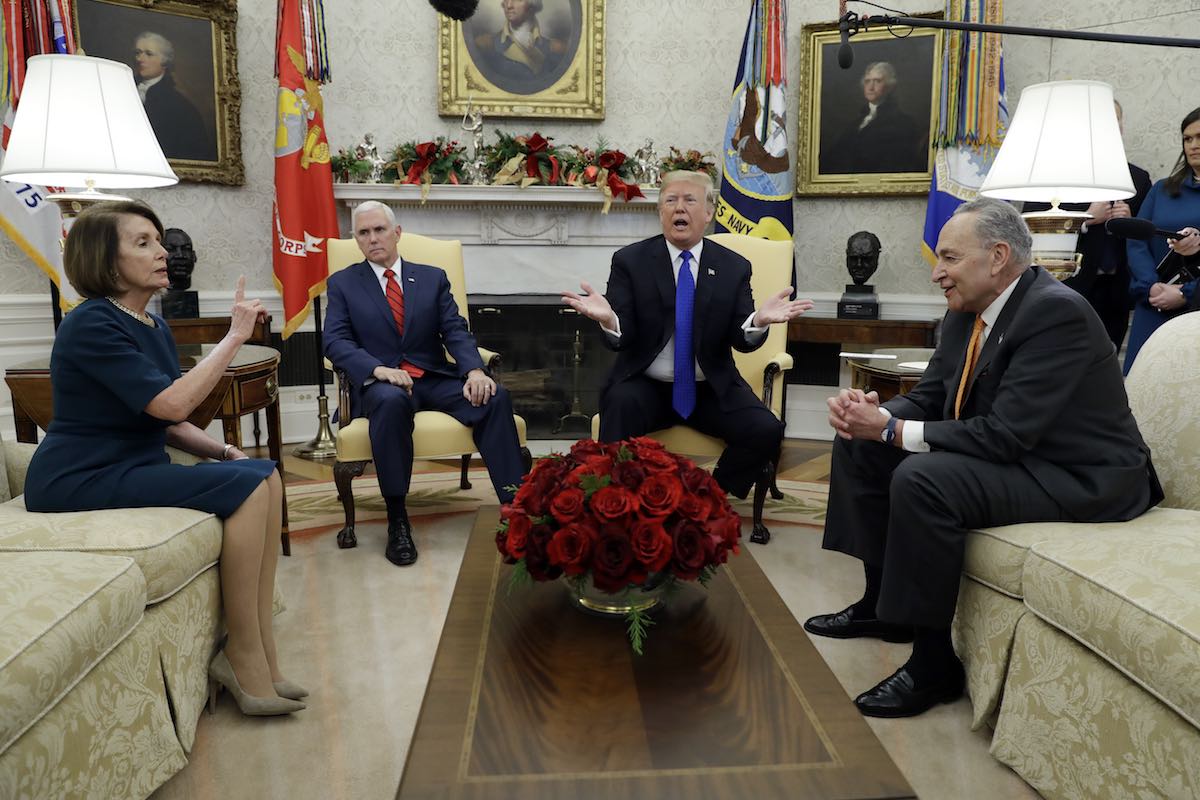Stand up for the facts!
Our only agenda is to publish the truth so you can be an informed participant in democracy.
We need your help.
I would like to contribute

President Donald Trump at a campaign rally on Sept. 29, 2018, in Wheeling, W.Va. (AP/Pablo Martinez Monsivais)
"Promises made, promises kept," went President Donald Trump’s slogan at rally after rally during the midterm elections.
It's a lofty mantra. How did he really do?
At his first term’s halfway point, almost half of his promises from the 2016 campaign have been blocked or dropped. On the positive side, close to a third of his goals were achieved or saw partial progress.
Trump had two years with Republicans in control of Congress to turn his campaign priorities into accomplishments. But he was unable to repeal and replace the Affordable Care Act, build a wall and make Mexico pay for it, or introduce an infrastructure package.
He enters his third year with a divided government, Democrats eager to dim the chances for some of his more conservative proposals.
Sign up for PolitiFact texts
Trump’s agenda found more success when he could act alone. Through his executive power, Trump raised tariffs on imported goods, renegotiated the North American Free Trade Agreement and continued to chip away at President Barack Obama’s legacy on the environment and foreign policy.
"Trump has been vastly more successful, despite Republican control of both houses, in using his executive powers to fulfill promises rather than getting significant legislative accomplishments through the Congress," said Allan Lichtman, a political historian at American University. "In a sense, that contradicts one of his biggest promises, which is, ‘I’m a deal maker.’"
PolitiFact’s Trump-O-Meter is tracking the progress of 102 promises Trump made on the campaign trail.
• PolitiFact rated 17 Trump pledges Promise Kept, with another 11 rated Compromise. That means Trump achieved complete or partial success on about 27 percent of his promises during his first two years in office.
• Another 28 promises, or about 27 percent, are rated In the Works, which means he’s taken some action but it’s too soon to tell the outcome.
• PolitiFact rated 18 promises as Broken and another 28 as Stalled, meaning no significant action has been achieved. Put another way, 45 percent of Trump’s promises have run into significant obstacles during the first half of his tenure.
An increasingly polarized Congress partly explains Trump’s limited success. But Trump's priorities have been hampered by division within his Republican ranks.
"Among the reasons the president was not able to get something done on health care, for example, was primarily a difference between the wings within the Republican party," said Brandon Rottinghaus, a professor of political science at the University of Houston. "That divide is as important as the divide between the Congress and the White House."
Trump’s election placed the long-held Republican goal to repeal the Affordable Care Act within reach: Republicans had introduced over 60 bills to repeal, modify or curb the law when Obama was president. But the unity against Obamacare wasn’t as reliable as it appeared.
Alongside Sen. Lisa Murkowski of Alaska and Sen. Susan Collins of Maine, one of the key votes that stood in Trump’s way to repeal Obamacare was former Sen. John McCain of Arizona. When the potential tiebreaker came before the Senate chair on the most promising repeal bill, McCain turned his thumb down. Trump rarely failed to bring it up while stumping for other conservatives, even as McCain battled an aggressive form of brain cancer.
"We had it done, folks. It was done, and then early in the morning, somebody turned their hand in the wrong direction," Trump said to loud boos at a May rally in Nashville, Tenn., three months before McCain’s death. "That cost our country a lot. That was a very, very terrible thing to happen."
Ultimately, repealing the health care law proved too politically costly without a more promising alternative. Republican candidates found themselves in 2018 fending attacks on their previous votes to undermine the law and its protection on pre-existing conditions.
Lasting wins for Republicans
Where Republicans were united, Trump found the most success.
Trump signed the Tax Cuts and Jobs Act in December 2017, resulting in reduced tax rates for individuals, a reduction in the business tax rate and a reduction of the estate tax.
He also won the nomination of over 80 federal judges, including two Supreme Court justices. Trump made good on his promise to fill the late Justice Antonin Scalia's seat on the Supreme Court with a nominee (Neil Gorsuch) from a list rooted in the campaign. And in his second year, he nominated Justice Brett Kavanaugh to succeed Anthony Kennedy.

Supreme Court nominee Brett Kavanaugh is sworn in to testify before the Senate Judiciary Committee on Capitol Hill in Washington on Sept. 27, 2018. (AP)
Kavanaugh’s nail-biter 51-49 confirmation — following a special hearing and FBI investigation into sexual assault allegations by Christine Blasey Ford — gave Trump a significant win, shifting the court to its most conservative era in modern history.
"The big one is appointing conservative Supreme Court justices," said Tommy Binion, vice president of policy outreach at the conservative Heritage Foundation. "Probably the thing he has done that has the biggest impact is Gorsuch and Kavanaugh."
Lack of experience showed on tough subjects
Trump has shown a limited appetite for engaging in the legislative process to advance more challenging ideas.
Trump focused on his own supporters while ignoring the wishes of his potential negotiating partners across the aisle. On the midterm rally circuit, he fueled animosity over any sort of compromise with Democrats — often with a scant backing of facts.
"If Nancy Pelosi, crying Chuck Schumer, and the radical Democrats take over Congress, they will try to raise your taxes, they will immediately restore job-killing regulations, they will impose, believe it or not, socialism, take away your health care, your health care and your whole life will be unaffordable, shut down immediately, oh, forget this one, shut down your coal mines in about two minutes," Trump said in Lexington, Ky., in October.

President Donald Trump gestures while speaking at a campaign rally on Sept. 29, 2018, in Wheeling, WV. (AP)
"He did not make the transition from a candidate with a defined constituency to president of all the people," said Martha Joynt Kumar, director of the White House Transition Project.
The other obstacle in advancing his promises, Kumar said, is Trump’s lack of legislative experience and turnover among his staff and cabinet.
"Kumar calculated 73 percent of Trump’s top-level staff have left the White House."
"Other presidents don’t have anything like that kind of turnover," Kumar said. "If you don’t have a continuing staff, it’s difficult to plan, in the medium and long range, how you’re going to accomplish something. As soon as people develop their knowledge of how the place works, they leave."
Some of Trump’s main promises centered around historically challenging policy areas where even most Republicans disagree — especially immigration. Without legislative know-how, Trump was unable to conquer challenges that also tormented his predecessors.
In 2006, George W. Bush supported a bill to strengthen border security with fencing, introduce a path to legal status for long-term immigrants and introduce a new visa program. It was never taken up by the House. In 2010, Barack Obama tried and failed to pave a legal path to citizenship for alien minors. Again in 2013, Obama supported a bill to increase Border Patrol agents and allow a path to legal citizenship, which was not taken up by the House.
Read: How Obama's promises fared after second year
Obama skirted those failures with an executive branch memorandum that allowed immigrants who came to the United States illegally as minors to stay in the country. (Trump’s efforts to overturn that failed.)
The wall
Trump failed to sell Democrats and even some Republicans on his border wall. The result? The longest government shutdown in history. We rated Trump’s promise to build a border wall and make Mexico pay for it Stalled.
Trump’s promise to make Mexico pay for a wall represents a bigger pattern in some of his promises: the rhetoric earned him adulation during the campaign, but they were not grounded in a realistic strategy.
For example, Trump now claims he never meant Mexico was "going to write out a check" for direct payment. That contradicts policy papers from his own campaign, when he called a one-time payment of $5 billion to $10 billion an easy decision for Mexican leaders. When Mexico’s president said it would not ever pay for a wall, Trump quipped, "The wall just got 10 feet higher."
"Usually, rhetorical promises are vague enough where they can be effective but not cost the president any real capital," Rottinghaus said. "Whereas this promise was very specific, and we’re seeing where that gets us."
Trump’s other immigration promises saw mixed success. Trump failed to cancel funding of sanctuary cities because courts have found legal shortcomings in his approach. His ban on immigration from terror-prone places succeeded a court challenge after its third, more targeted attempt.
Moving on his own, at his own risk
Trump had the biggest impact through executive action, following in the footsteps of Obama and Bush.
That approach yielded some of his biggest wins in foreign policy: moving the U.S. embassy in Tel Aviv to Jerusalem, canceling the Paris climate agreement, asking allies to pay more for joint defense, stopping the Trans-Pacific Partnership trade deal and raising tariffs on imported goods.

Ivanka Trump and U.S. Treasury Secretary Steve Mnuchin attend the opening ceremony of the new U.S. embassy in Jerusalem on May 14, 2018. (AP)
Trump’s promise to renegotiate the Iran deal, on the other hand, is Stalled. He pulled the United States out of the Obama-era accord, but he has not struck a deal to replace it.
Trump’s promise to renegotiate NAFTA is In the Works. He brought Mexico and Canada together to sign a deal that, while not significantly different from the old one, mostly favored the United States. The treaty awaits legislative approval in each country.
Experts warned that promises advanced through executive action have a greater chance of being reversed by the next president; many of Trump’s advances were in fact in the reversal of Obama-era regulations.
"The area where Trump has had the biggest impact has been without Congress, using the powers of executive branch particularly in deregulation," said Guian McKee, an associate professor in presidential studies at the University of Virginia’s Miller Center. "The trade-off is they can do a lot of things but it is, generally speaking, going to be less permanent than legislative action. The next president can reverse those."
Can he work with Congress?
Looking ahead, Trump has 56 promises that will require greater cooperation with Congress to push them out of limbo.
For example, Trump has not made concrete legislative proposals on any of his infrastructure promises. His pledge to rebuild crumbling infrastructure and use U.S. steel have fallen flat.

Trump and Vice President Mike Pence meet with Schumer and Pelosi in the Oval Office on Dec. 11, 2018. (AP)
The day after his party lost the House of Representatives, Trump said he was willing to negotiate with Democrats on infrastructure, and said the two sides share much common ground. But experts are less optimistic.
The tax law has ballooned the federal deficit, making future spending without agreement on cutbacks that much harder. (Trump broke his promise to balance the federal budget.)
If the shutdown with which he enters his third year is any indication, the path ahead looks gloomy for Trump’s second half. Compromise across the aisle will be a requirement if he wishes to fulfill his remaining promises. And newly empowered Democrats are poised to riddle the path with scrutiny on Trump’s finances and the Russia investigation.
"I don’t see where he’s going to manage to look forward when his presidency has been one where he has spent so much time looking backwards," Kumar said. "That unwillingness to leave the past behind and pull together your energies for what you can get done — he simply hasn’t done that."
Correction: The report has been changed to reflect that 73 percent of Trump’s top-level staff have left the White House, not just first-year hires.
Our Sources
Phone interview with Guian McKee, an associate professor in presidential studies at the University of Virginia’s Miller Center, Jan. 10, 2019
Phone interview with Tommy Binion, vice president of policy outreach at the conservative Heritage Foundation, Jan. 9, 2019
Phone interview with Brandon Rottinghaus, a professor of political science at the University of Houston, Jan. 9, 2019
Phone interview with Martha Joynt Kumar, director of the White House Transition Project, Jan. 14, 2019
Phone interview with Allan Lichtman, a political historian at American University, Jan. 9, 2019
PolitiFact, Long odds against repeal with Democrats running the House, Jan. 7, 2019
PolitiFact, Build a wall, and make Mexico pay for it, Jan. 14, 2019
PolitiFact, Invest $550 billion in infrastructure and create an infrastructure fund, Jan. 7, 2019
PolitiFact, Raise tariffs on goods imported into the U.S., July 18, 2019
PolitiFact, Renegotiate NAFTA, Dec. 11, 2019
PolitiFact, Promises about Foreign Policy on Trump-O-Meter
PolitiFact, Cancel the Paris climate agreement, June 1, 2017
PolitiFact, Promise Kept rulings on Trump-O-Meter
PolitiFact, Compromise rulings on Trump-O-Meter
PolitiFact, In the Works rulings on Trump-O-Meter
PolitiFact, Promise Broken rulings on Trump-O-Meter
PolitiFact, Stalled rulings on Trump-O-Meter
Newsweek, GOP aims to kill Obamacare yet again after failing 70 times, July 29, 2017
NBC News, Trump rips McCain at political rally, May 30, 2018
PolitiFact, Eliminate the estate tax
PolitiFact, Nominate someone from his list of justices to replace Antonin Scalia, Jan. 16, 2017
Federal Judiciarl Center, Biographical Directory of Article III Federal Judges, 1789-present, accessed Jan. 11, 2019
C-SPAN, President Trump Rally in Richmond, Kentucky, Oct. 13, 2018
PolitiFact, Did Senate pass immigration bills in 2006, 2013 and House failed to vote on them?, Jan. 26, 2018
PolitiFact, Terminate Barack Obama's immigration executive orders 'immediately', Jan. 11, 2019
CNN, This is the longest shutdown in US history, Jan. 15, 2019
PolitiFact, Build a wall, and make Mexico pay for it, Jan. 14, 2019
PolitiFact, Trump says he didn't say Mexico would write US a check for border wall. But he did, Jan. 10, 2019
PolitiFact, Suspend immigration from terror-prone places, June 26, 2018












































